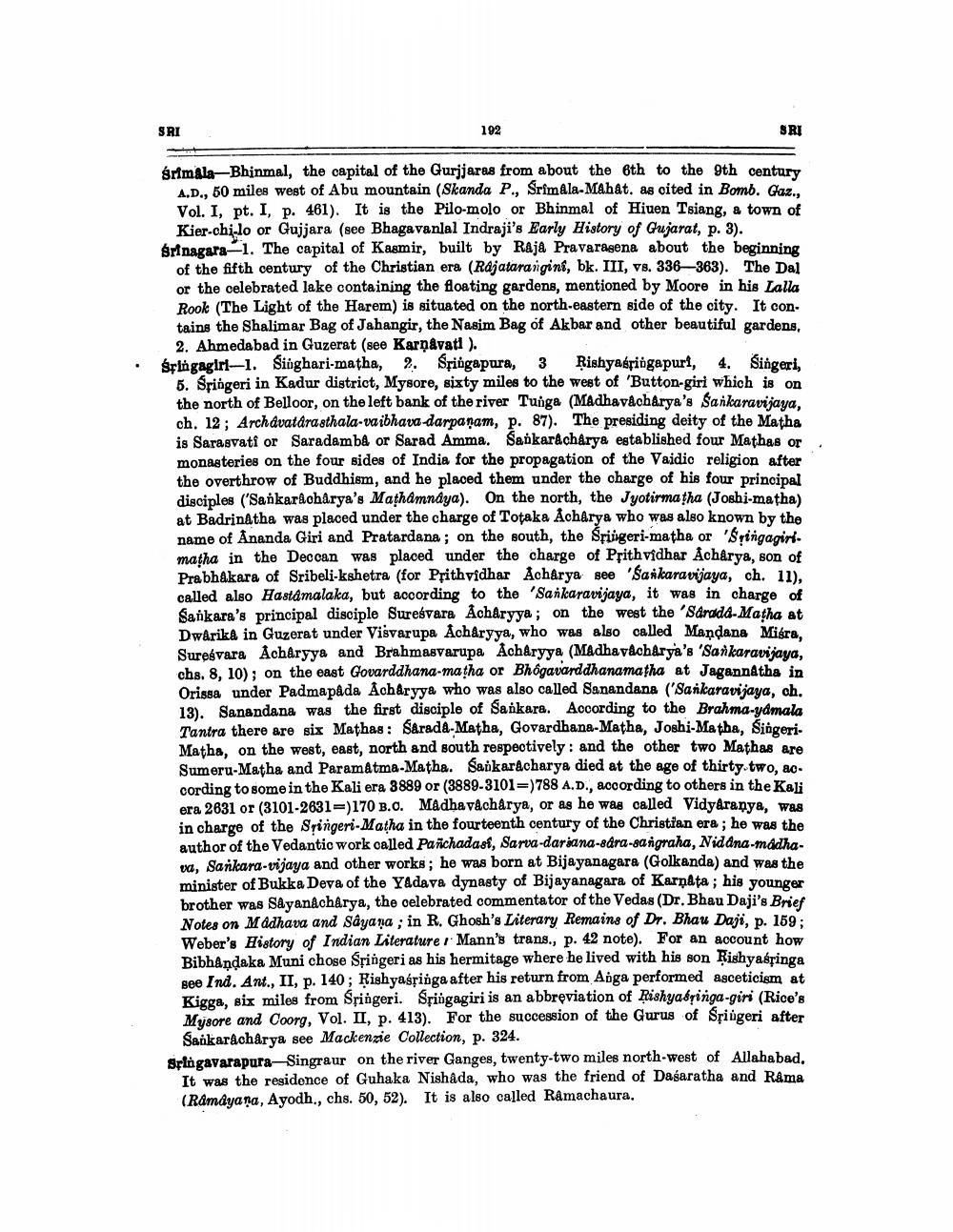________________
SRI
192
SRI
ármal-Bhinmal, the capital of the Gurjjaras from about the 6th to the 9th century
A.D., 60 miles west of Abu mountain (Skanda P., Srimala-Mahat, as oited in Bomb. Gaz.. Vol. I, pt. I, p. 461). It is the Pilo-molo or Bhinmal of Hiuen Tsiang, a town of
Kier-chi-lo or Gujjara (see Bhagavanlal Indraji's Early History of Gujarat, p. 3). Srinagara-1. The capital of Kasmir, built by Raja Pravaragena about the beginning
of the fifth century of the Christian era (Rajatararigini, bk. III, vs. 336363). The Dal or the celebrated lake containing the floating gardens, mentioned by Moore in his Lalla Rook (The Light of the Harem) is situated on the north-eastern side of the city. It con. tains the Shalimar Bag of Jahangir, the Nasim Bag of Akbar and other beautiful gardens.
2. Ahmedabad in Guzerat (see Karnavati ). Śfingagiri-1. Singhari-matha, 2. Singapura, 3 Rishyassiógapuri, 4. Singeri,
5. Sringeri in Kadur district, Mysore, sixty miles to the west of 'Button-giri which is on the north of Belloor, on the left bank of the river Tunga (Madhavacharya's Sankaravijaya, ch. 12; Archavatarasthala-vaibhava darpanam, p. 87). The presiding deity of the Matha is Sarasvati or Saradambe or Sarad Amma. Sankaracharya established four Mathas or monasteries on the four sides of India for the propagation of the Vaidic religion after the overthrow of Buddhism, and he placed them under the charge of his four principal disciples (Sankaracharya's Mathamndya). On the north, the Jyotirmatha (Joshi-matha) at Badrinatha was placed under the charge of Totaka Acharya who was also known by the name of Ananda Giri and Pratardana ; on the south, the Sringeri-matha or 'Sringagirimatha in the Deccan was placed under the charge of Prithvidhar Acharya, son of Prabhakara of Sribeli-kshetra (for Prithvidhar Acharya see 'Sarkaravijaya, ch. 11). called also Hastamalaka, but according to the 'Sankaravijaya, it was in charge of Sankara's principal disciple Suresvara Acharyya; on the west the 'Sarada-Matha at Dwarika in Guzerat under Visvarupa Acharyya, who was also called Mandana Migra. Suresvara Acharyya and Brahmasvarupa AchAryya (Madhavacharya's 'Sankaravijaya, chs. 8, 10); on the east Govarddhana-matha or Bhogavarddhanamatha at Jagannatha in Orisga under Padmapada Acharyya who was also called Sanandana ('Sarkaravijaya, ch. 13). Sanandana was the first disciple of Sankara. According to the Brahma-yamala Tantra there are six Mathas: Sarada-Matha, Govardhana-Matha, Joshi-Matha, Singeri. Matha, on the west, east, north and south respectively: and the other two Mathas are Sumeru-Matha and Paramåtma-Matha. Sankaracharya died at the age of thirty two, ac cording to some in the Kali era 8889 or (3889-3101=)788 A.D., according to others in the Kali era 2631 or (3101-2631)170 B.O. Madhavacharya, or as he was called Vidyaranya, was in charge of the Sringeri-Matha in the fourteenth century of the Christian era; he was the author of the Vedantio work called Panchadasi, Sarva-darsana-8dra-sangraha, Nidana-madhava, Sankara-vijaya and other works; he was born at Bijayanagara (Golkanda) and was the minister of Bukka Deva of the Yadava dynasty of Bijayanagara of Karnata; his younger brother was Sayanacharya, the celebrated commentator of the Vedas (Dr. Bhau Daji's Brief Notes on Madhava and Sayaņa ; in R. Ghosh's Literary Remains of Dr. Bhau Daji, p. 159; Weber's History of Indian Literature r Mann's trans., p. 42 note). For an account how Bibh&ndaka Muni chose Sringeri as his hermitage where he lived with his son Rishyabringa see Ind. Ant., II, p. 140; Rishyaśpinga after his return from Anga performed asceticism at Kigga, six miles from Spirgeri. Spiógagiri is an abbreviation of ķishyabringa-giri (Rice's Mysore and Coorg, Vol. II, p. 413). For the succession of the Gurus of Spiúgeri after
Sankaracharya see Mackenzie Collection, p. 324. Splågavarapura Singraur on the river Ganges, twenty-two miles north-west of Allahabad.
It was the residence of Guhaka Nishada, who was the friend of Dasaratha and Rama (Ramayana, Ayodh., chs. 50, 52). It is also called Ramachaura.




